Spatio-Temporal Evolution and Multi-Scenario Prediction of Ecosystem Carbon Storage in Chang-Zhu-Tan Urban Agglomeration Based on the FLUS-InVEST Model
Abstract
1. Introduction
2. Data Sources and Methods
2.1. Study Area
2.2. Data Sources and Processing
2.3. Methods
2.3.1. Research Framework
2.3.2. Carbon Storage Estimation Based on the InVEST Model
2.3.3. FLUS Model
2.3.4. FLUS Model Parameters Setting
2.3.5. Land Use Dynamic Degree
2.3.6. Spatial Autocorrelation Analysis Based on GIS
3. Results and Discussion
3.1. Analysis of Land Use Change in Chang-Zhu-Tan Urban Agglomeration
3.2. Spatial and Temporal Evolution of Carbon Storage from 2010 to 2020
3.3. Relationship between Land Use Change and Carbon Storage under Multi-Scenarios
3.3.1. Impact of Future Land Use Change on Carbon Storage under Multi-Scenarios
3.3.2. Spatial Autocorrelation Analysis of Carbon Storage under Multi-Scenarios
3.4. Limitations
4. Conclusions and Advice
4.1. Conclusions
4.2. Advice
Author Contributions
Funding
Institutional Review Board Statement
Informed Consent Statement
Data Availability Statement
Conflicts of Interest
References
- Tao, B.; Ge, Q.S.; Li, K.R.; Shao, X.M. Progress in the studies on carbon cycle in terrestrial ecosystem. J. Geogr. Res. 2001, 20, 564–575. [Google Scholar] [CrossRef]
- Xiang, S.J.; Zhang, Q.; Wang, D.; Wang, S.; Wang, Z.F.; Xie, Y.Q.; Gao, M. Response and vulnerability analysis of carbon storage to LUCC in the main urban area of Chongqing during 2000–2020. J. Nat. Resour. 2022, 37, 1198–1213. [Google Scholar] [CrossRef]
- Ge, Q.S.; Dai, J.H.; He, F.N.; Pan, Y.; Wang, M.M. Study on Land Use, Land Cover Change and Carbon Cycle in China over the Past 300 Years. Sci. China Earth Sci. 2008, 2, 197–210. [Google Scholar] [CrossRef]
- Liu, M.Y.; Bao, A.M.; Chen, X.; Liu, H.L.; Zhang, H.L.; Chen, X.N. Impact of Land Use/Cover Change on theVegetation Carbon Storageinthe Manas River Basin between 1976 and 2007. J. Nat. Resour. 2010, 25, 926–938. [Google Scholar] [CrossRef]
- Yang, H.; Huang, J.L.; Liu, D.F. Linking climate change and socioeconomic development to urban land use simulation: Analysis of their concurrent effects on carbon storage. J. Appl. Geogr. 2020, 115, 102135. [Google Scholar] [CrossRef]
- Duan, L.; Lu, M.S.; Cai, Y.J.; Ling, Y.R.; Fan, T.S.; Li, Z. Analysis and Prediction of Ecosystem Carbon Storage Evolution in Chinese Provinces and Cities Along the Maritime Silk Road Economic Belt. Soil. Water Conserv. 2024, 38, 242–254. [Google Scholar] [CrossRef]
- Hoque, M.Z.; Cui, S.H.; Islam, I.; Lilai Xu, L.L.; Ding, S.P. Dynamics of plantation forest development and ecosystem carbon storage change in coastal Bangladesh. Ecol. Indic. 2021, 130, 107954. [Google Scholar] [CrossRef]
- Mirici, M.E.; Berberoglu, S. Terrestrial carbon dynamics and economic valuation of ecosystem service for land use management in the Mediterranean region. Ecol. Inform. 2024, 81, 102570. [Google Scholar] [CrossRef]
- Waleed, M.; Sajjad, M.; Shazil, M.S. Urbanization-led land cover change impacts terrestrial carbon storage capacity: A high-resolution remote sensing-based nation-wide assessment in Pakistan (1990–2020). Environ. Impact Assess. Rev. 2024, 105, 107396. [Google Scholar] [CrossRef]
- Zafar, Z.; Zubair, M.; Zha, Y.Y.; Mehmood, M.S.; Rehman, A.; Fahd, S.; Nadeem, A.A. Predictive modeling of regional carbon storage dynamics in response to land use/land cover changes: An InVEST-based analysis. Ecol. Indic. 2024, 82, 102701. [Google Scholar] [CrossRef]
- Aitali, R.; Snoussi, M.; Kolker, A.S.; Oujidi, B.; Mhammdi, N. Effects of Land Use/Land Cover Changes on Carbon Storage in North African Coastal Wetlands. J. Mar. Sci. Eng. 2022, 10, 364. [Google Scholar] [CrossRef]
- Dar, S.A.; Dar, J.A. Linking carbon storage with land use dynamics in a coastal Ramsar wetland. Sci. Total Environ. 2024, 932, 173078. [Google Scholar] [CrossRef] [PubMed]
- Hernández-Guzmán, R.; Ruiz-Luna, A.; González, C. Assessing and modeling the impact of land use and changes in land cover related to carbon storage in a western basin in Mexico. Remote Sens. Appl. 2019, 13, 318–327. [Google Scholar] [CrossRef]
- Saluja, R.; Maung, T.M.; Piman, T.; Loc, H.H. Land Use Transitions in the Lower Songkhram River Basin in Mekong and Its Impact on Carbon Sequestration Potential. ACS EST Water 2024, 4, 2918–2931. [Google Scholar] [CrossRef]
- Vizcaíno-Bravo, Q.; Williams-Linera, G.; Asbjornsen, H. Biodiversity and carbon storage are correlated along a land use intensity gradient in a tropical montane forest watershed, Mexico. Basic. Appl. Ecol. 2020, 44, 24–34. [Google Scholar] [CrossRef]
- Yang, X.; Liu, X.Z. Carbon conduction effect and temporal-spatial difference caused by land type transfer in Chang-Zhu-Tan urban agglomeration from 1995 to 2018. Acta Ecol. Sin. 2022, 42, 338–347. [Google Scholar] [CrossRef]
- Zhang, X.; Liu, L.Y.; Chen, X.D.; Gao, Y.; Xie, S.; Mi, J. GLC_FCS30: Global land-cover product with fine classification system at 30 m using time-series Landsat imagery. Earth Syst. Sci. Data 2021, 13, 2753–2776. [Google Scholar] [CrossRef]
- Ouyang, X.; Tang, L.S.; Wei, X.; Li, Y.H. Spatial interaction between urbanization and ecosystem services in Chinese urban agglomerations. J. Land. Use Policy 2021, 109, 105587. [Google Scholar] [CrossRef]
- Ouyang, X.; Wang, K.; Wei, X. Impacts of Urban-Rural Construction Land Linkages on Ecosystem Services: A Case Study of Dongting Lake Area. Acta Ecol. Sin. 2022, 42, 8713–8722. [Google Scholar] [CrossRef]
- Mi, Y.; LI, T.; Wu, B.; Zhao, Y.P. Spatio-temporal evolution and prediction of carbon storage in Chang-Zhu-Tan 3+5 urban agglomeration based on optimization simulation. Environ. Eng. Technol. Sin. 2023, 13, 1740–1751. [Google Scholar] [CrossRef]
- Rachid, L.; Elmostafa, A.; Mehdi, M.; Hassan, R. Assessing carbon storage and sequestration benefits of urban greening in Nador City, Morocco, utilizing GIS and the InVEST model. Sustain. Futures 2024, 7, 100171. [Google Scholar] [CrossRef]
- Wang, H.Y.; Wu, L.S.; Yue, Y.S.; Jin, Y.Y.; Zhang, B.B. Impacts of climate and land use change on terrestrial carbon storage: A multi-scenario case study in the Yellow River Basin (1992–2050). Sci. Total Environ. 2024, 930, 172557. [Google Scholar] [CrossRef]
- Zhu, L.Y.; Song, R.X.; Sun, S.; Li, Y.; Hu, K. Land use/land cover change and its impact on ecosystem carbon storage in coastal areas of China from 1980 to 2050. Ecol. Indic 2022, 142, 109178. [Google Scholar] [CrossRef]
- Ouyang, X.; He, Q.Y.; Zhu, X. Simulation of Impacts of Urban Agglomeration Land Use Change on Ecosystem Services Value under Multi-Scenarios: Case Study in Changsha-Zhuzhou-Xiangtan Urban Agglomeration. J. Econ. Geogr. 2020, 40, 93–102. [Google Scholar] [CrossRef]
- Wang, M.C.; Guo, X.; Wang, F.Y.; Zhang, X.Y. Dynamic change and predictive analysis of land use types in Changchun city based on FLUS model. J. Jilin Univ. Earth Sci. Ed. 2019, 49, 1795–1804. [Google Scholar] [CrossRef]
- Su, Y.Q.; Liu, G.; Zhao, J.B.; Niu, J.J.; Zhang, E.Y.; Guo, L.G.; Lin, F. Multi-scenario simulation prediction of ecological space in the Fenhe River Basin using the FLUS model. J. Arid. Zone Res. 2021, 38, 1152–1161. [Google Scholar] [CrossRef]
- Zhang, J.D.; Mei, Z.X.; Lv, J.H.; Chen, J.Z. Simulating multiple land use scenarios based on the FLUS model considering spatial auto-correlation. Earth Inform. Sci. Sin. 2020, 22, 531–542. [Google Scholar] [CrossRef]
- Wang, Q.Z.; Guan, Q.Y.; Lin, J.K.; Luo, H.P.; Tan, Z.; Ma, Y.R. Simulating land use/land cover change in an arid region with the coupling models. Ecol. Indic. 2021, 122, 107231. [Google Scholar] [CrossRef]
- Gogoi, A.; Ahirwal, J.; Sahoo, U.K. Evaluation of ecosystem carbon storage in major forest types of Eastern Himalaya: Implications for carbon sink management. J. Environ. Manag. 2022, 302, 113972. [Google Scholar] [CrossRef] [PubMed]
- Freitas, W.L.; de Souza, M.C.R.; Amaral, J.A.; Bastiani, F.D. Exploratory spatial analysis for interval data: A new autocorrelation index with COVID-19 and rent price applications. Expert. Syst. Appl. 2022, 195, 116561. [Google Scholar] [CrossRef]
- Geng, L.L.; Zhang, Y.Y.; Hui, H.X.; Wang, Y.H.; Xue, Y.J. Response of Urban Ecosystem Carbon Storage to Land Use/Cover Change and Its Vulnerability Based on Major Function-Oriented Zone Planning. J. Land. 2023, 12, 1563. [Google Scholar] [CrossRef]
- Xu, M.; Deng, F.R.; Jia, S.; Jia, X.P.; Plaza, A.J. Attention mechanism-based generative adversarial networks for cloud removal in Landsat images. Remote Sens. Environ. 2022, 271, 112902. [Google Scholar] [CrossRef]
- Kumar, A.; Gorai, K.A. A comparative evaluation of deep convolutional neural network and deep neural network-based land use/land cover classifications of mining regions using fused multi-sensor satellite data. Adv. Space Res. 2023, 72, 4663–4676. [Google Scholar] [CrossRef]
- Zhang, Z.Y.; Lu, L.; Zhao, Y.H.; Wang, Y.Y.; Wei, D.D.; Wu, X.D.; Ma, X.L. Recent advances in using Chinese Earth observation satellites for remote sensing of vegetation. ISPRS J. Photogramm. 2023, 195, 393–407. [Google Scholar] [CrossRef]
- Zhou, J.J.; Zhao, Y.R.; Huang, P.; Zhao, X.; Feng, W.; Li, Q.Q.; Xue, D.X.; Dou, J.; Shi, W.; Wei, W.; et al. Impacts of ecological restoration projects on the ecosystem carbon storage of inland river basin in arid area, China. J. Ecol. Indic. 2020, 118, 106803. [Google Scholar] [CrossRef]
- Verstegen, J.A.; Laan, C.; Dekker, S.C.; Faaij, P.C.; Santos, M.J. Recent and projected impacts of land use and land cover changes on carbon stocks and biodiversity in East Kalimantan, Indonesia. Ecol. Indic. 2019, 103, 563–575. [Google Scholar] [CrossRef]
- Sun, W.L.; Liu, X.H. Review on carbon storage estimation of forest ecosystem and applications in China. J. For. Ecosyst. 2020, 7, 37–50. [Google Scholar] [CrossRef]
- Reang, D.; Hazarika, A.; Sileshi, G.W.; Pandey, R.; Das, A.K.; Nath, A.J. Assessing tree diversity and carbon storage during land use transitioning from shifting cultivation to indigenous agroforestry systems: Implications for REDD+ initiatives. J. Environ. Manag. 2021, 298, 113470. [Google Scholar] [CrossRef]
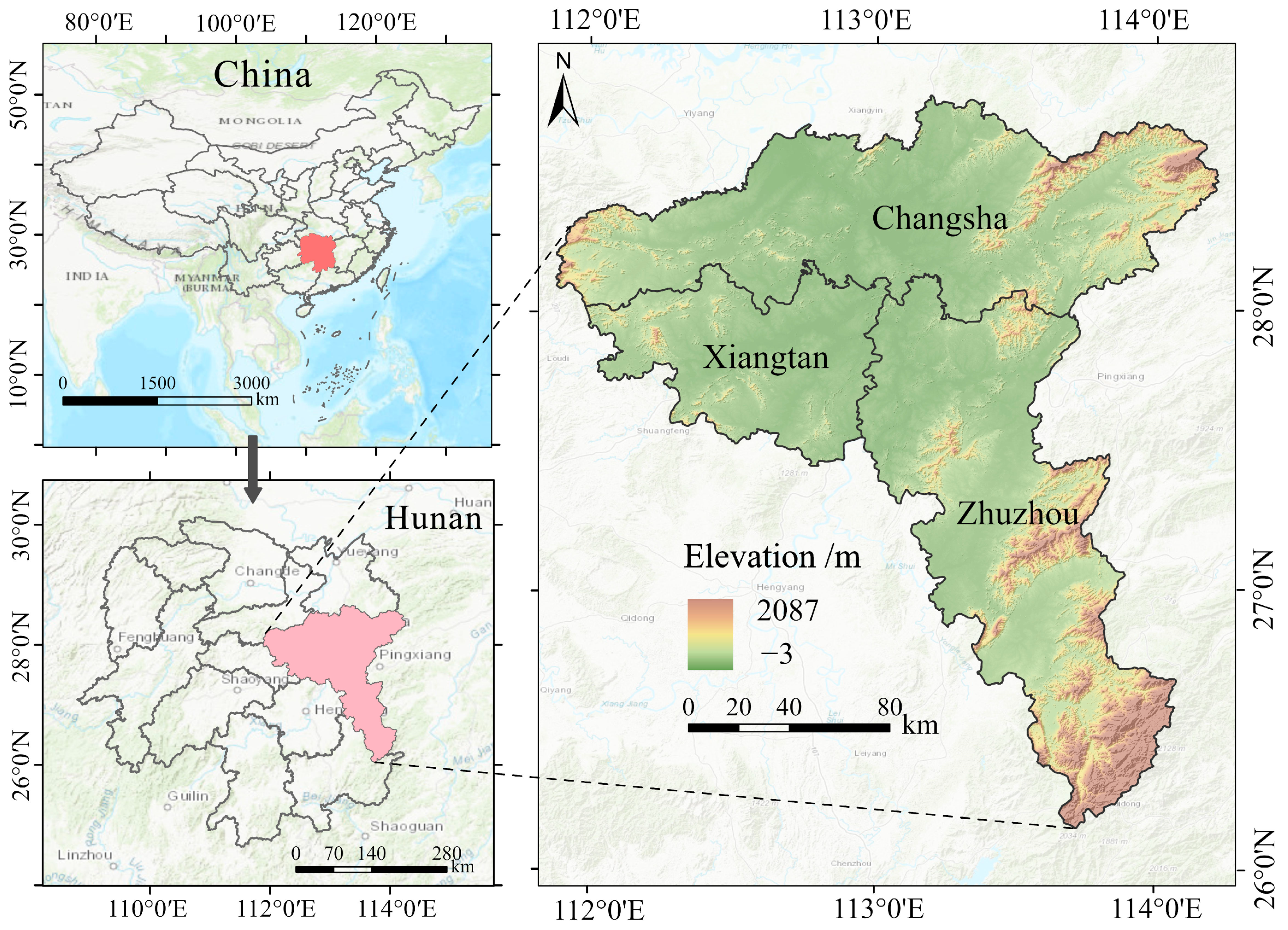
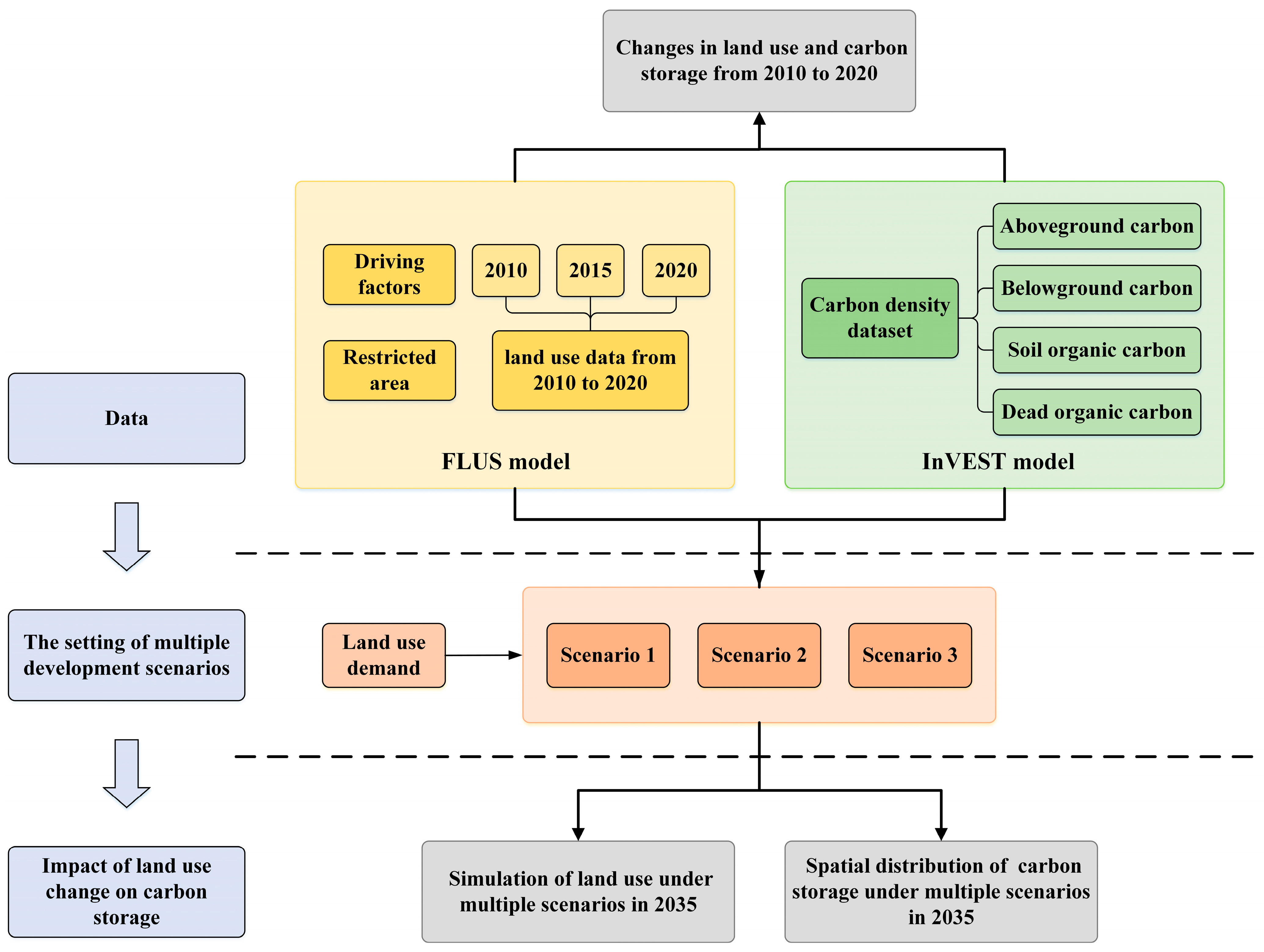
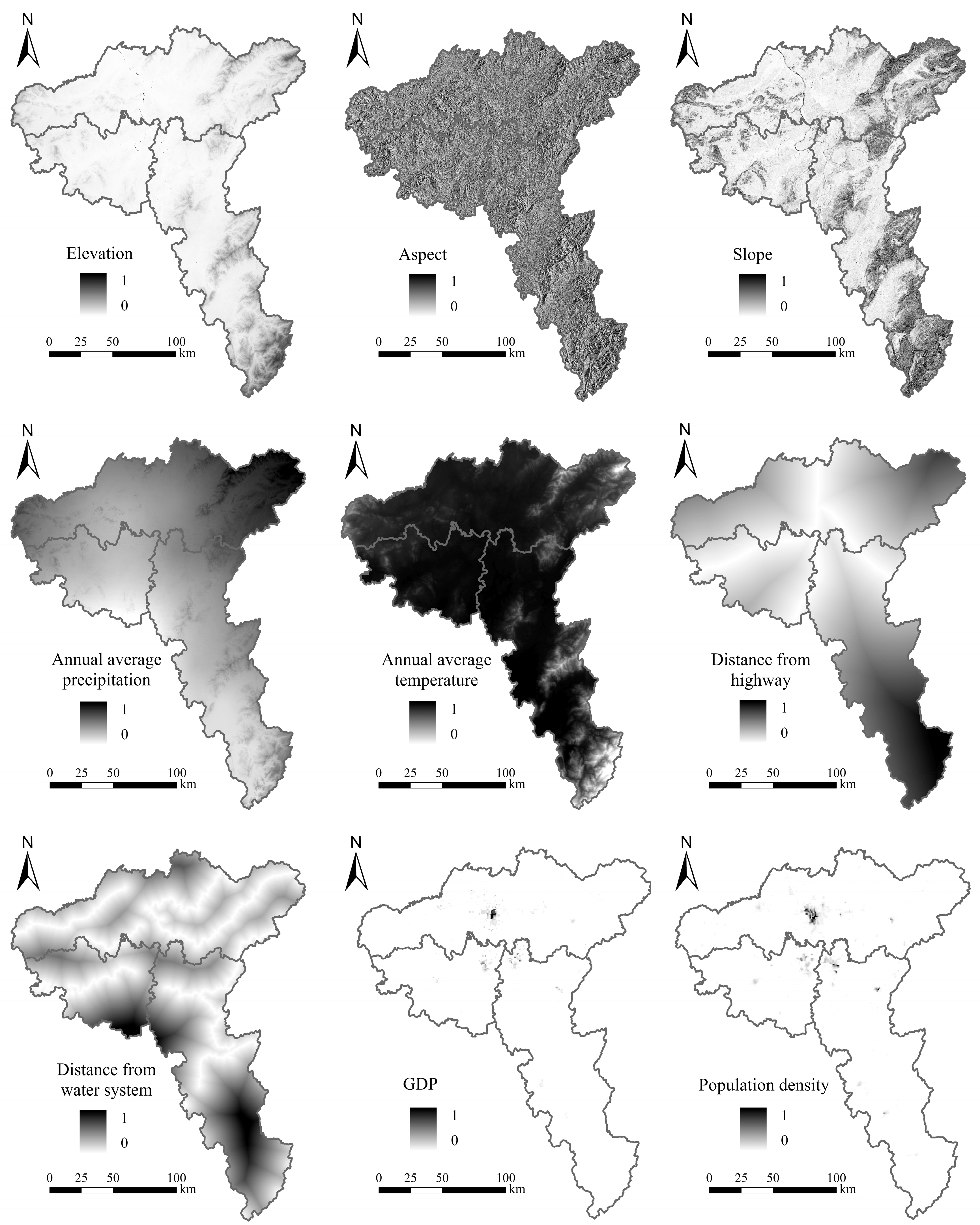
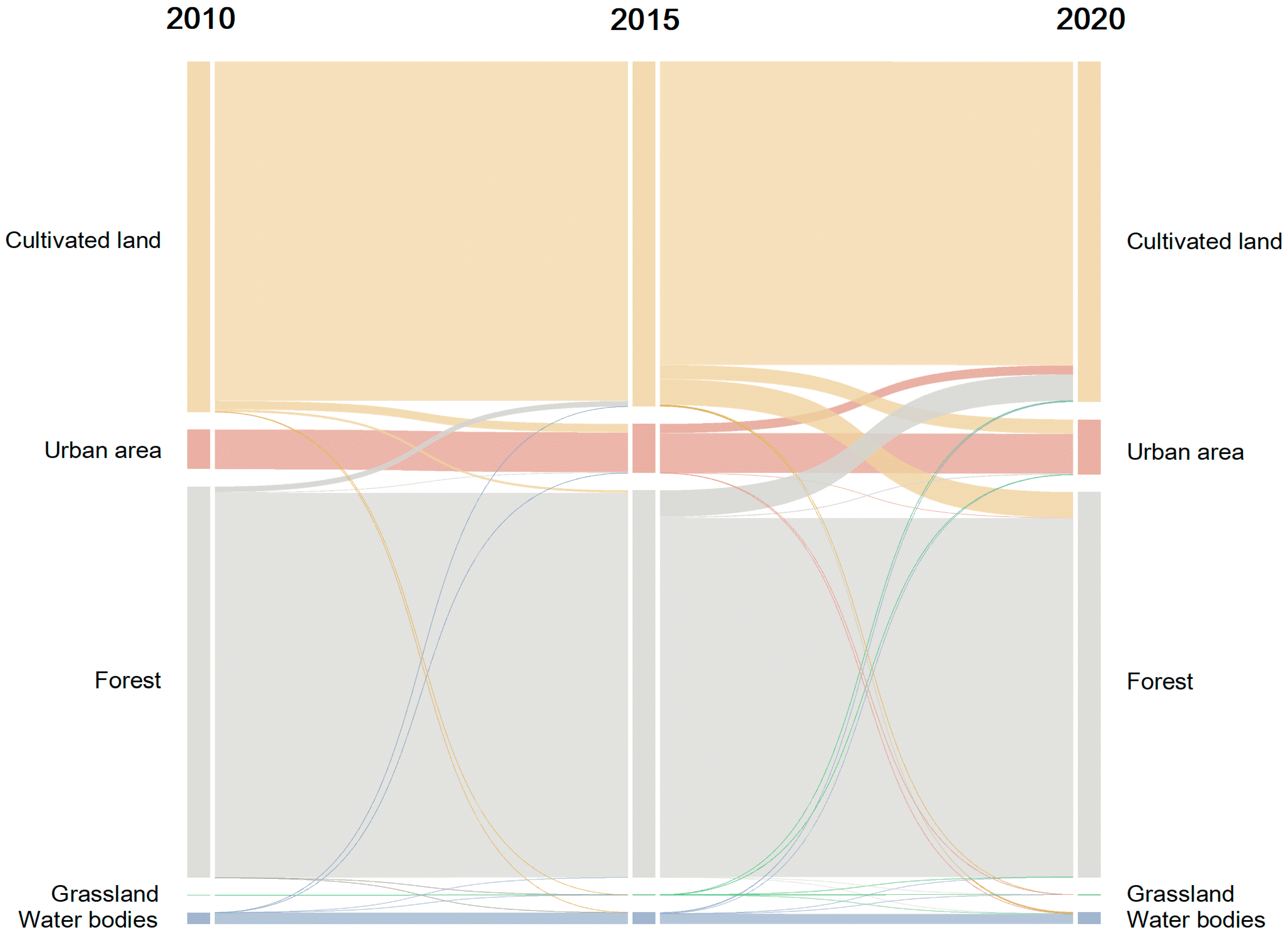

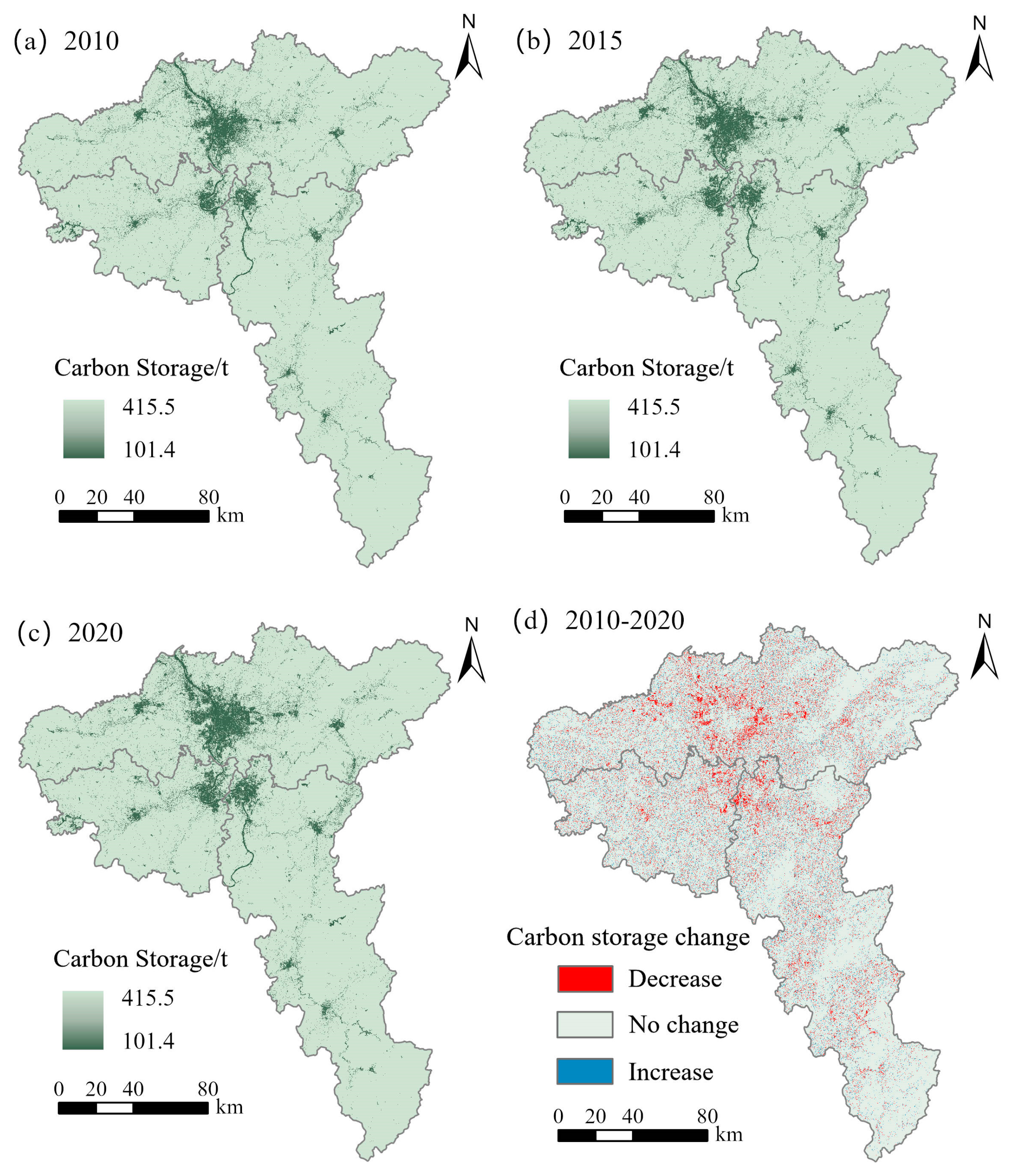

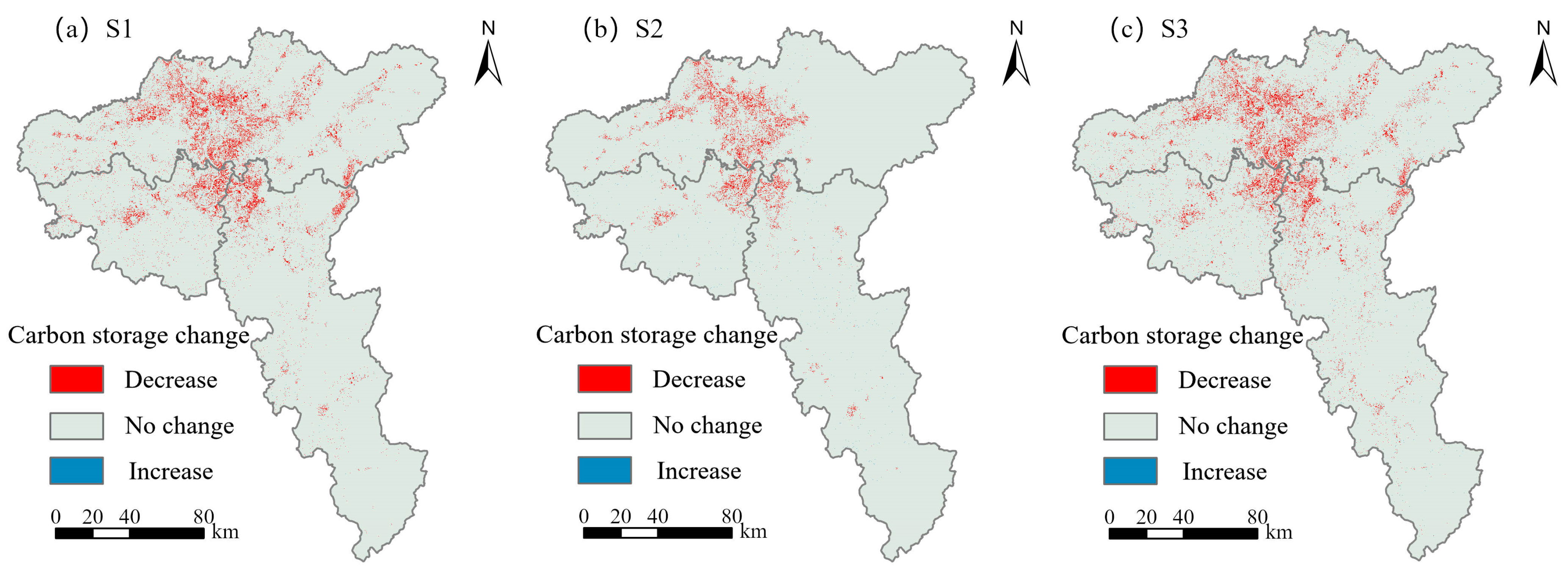
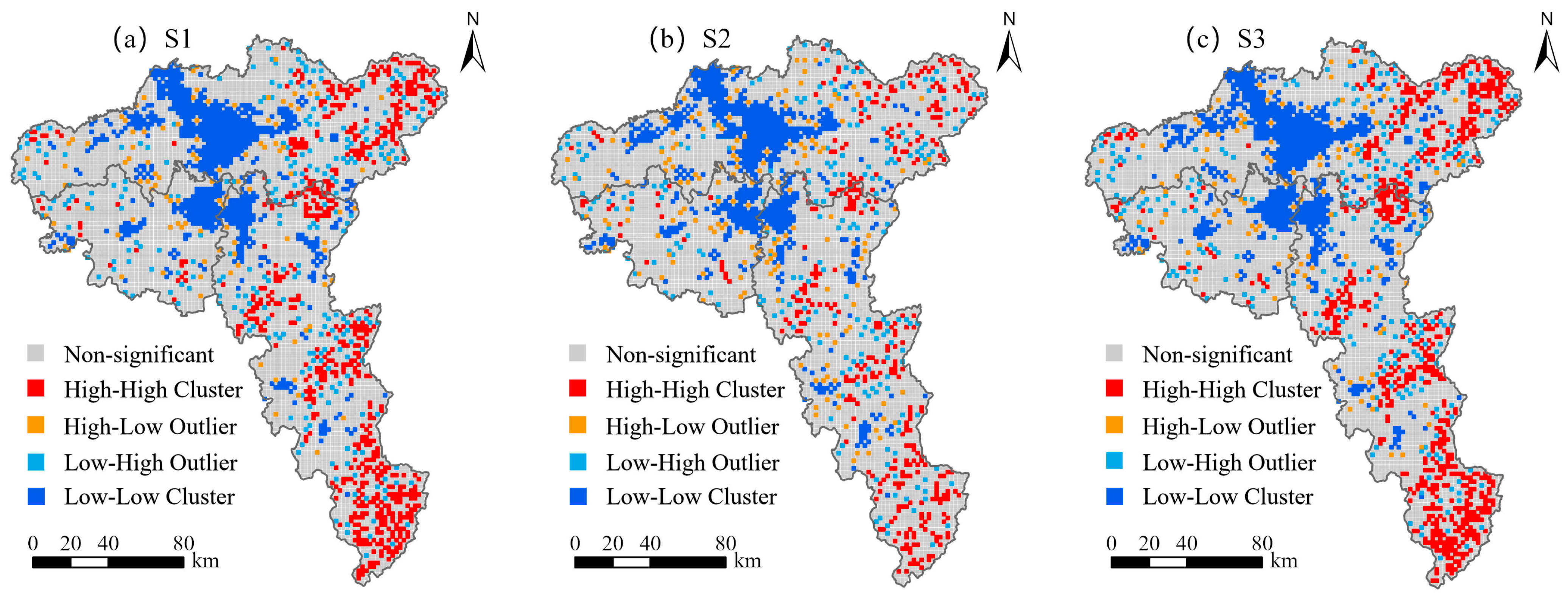
| Land Use Type | Cabove/(t/ha) | Cbelow/(t/ha) | Csoil/(t/ha) | Cdead/(t/ha) | Ctotal/(t/ha) |
|---|---|---|---|---|---|
| Cultivated land | 27.9 | 94.6 | 108.4 | 0.0 | 230.9 |
| Forest | 50.5 | 151.8 | 213.2 | 0.0 | 415.5 |
| Grassland | 22.8 | 86.5 | 99.9 | 0.0 | 209.2 |
| Water bodies | 22.4 | 79.0 | 0.0 | 0.0 | 101.4 |
| Urban area | 12.5 | 56.7 | 110.8 | 0.0 | 180.0 |
| Land Use Type | Cultivated Land | Forest | Grassland | Water Bodies | Urban Area |
|---|---|---|---|---|---|
| Neighborhood weight | 0.15 | 0.01 | 0.3 | 0.4 | 0.98 |
| Land Use Type | S1 | S2 | S3 | ||||||||||||
|---|---|---|---|---|---|---|---|---|---|---|---|---|---|---|---|
| A | B | C | D | E | A | B | C | D | E | A | B | C | D | E | |
| Cultivated land | 1 | 1 | 1 | 1 | 1 | 1 | 1 | 1 | 1 | 1 | 1 | 0 | 0 | 0 | 1 |
| Forest | 1 | 1 | 1 | 1 | 1 | 0 | 1 | 0 | 0 | 0 | 1 | 1 | 1 | 0 | 1 |
| Grassland | 1 | 1 | 1 | 1 | 1 | 0 | 1 | 1 | 1 | 0 | 1 | 1 | 1 | 1 | 1 |
| Water bodies | 1 | 1 | 1 | 1 | 1 | 0 | 1 | 1 | 1 | 0 | 1 | 1 | 0 | 1 | 1 |
| Urban area | 0 | 0 | 0 | 0 | 1 | 0 | 1 | 0 | 0 | 1 | 0 | 0 | 0 | 0 | 1 |
| Land Use Type | 2010–2015 | 2015–2020 | 2010–2020 | |||
|---|---|---|---|---|---|---|
| Change Area/km2 | Dynamic Degree/% | Change Area/km2 | Dynamic Degree/% | Change Area/km2 | Dynamic Degree/% | |
| Cultivated land | −199.33 | −0.32 | −166.32 | −0.27 | −365.65 | −0.29 |
| Forest | −143.29 | −0.21 | −60.09 | −0.09 | −203.38 | −0.15 |
| Grassland | 0.01 | 1.18 | 0.11 | 12.22 | 0.12 | 7.06 |
| Water bodies | 11.53 | 0.57 | 6.87 | 0.33 | 18.40 | 0.45 |
| Urban area | 331.08 | 4.69 | 215.67 | 2.48 | 546.75 | 3.88 |
| Scenario | Data Type | Land Use Type | ||||
|---|---|---|---|---|---|---|
| Cultivated Land | Forest | Grassland | Water Bodies | Urban Area | ||
| 2020 | carbon storage/105 t | 2784.69 | 5662.32 | 0.06 | 43.19 | 352.35 |
| S1 | change area/km2 | −588.19 | −502.94 | 0.07 | 32.48 | 1058.72 |
| carbon storage/105 t | 2684.88 | 5472.71 | 0.05 | 41.75 | 542.92 | |
| S2 | change area/km2 | −588.19 | 25.23 | 0.07 | 3.24 | 559.79 |
| carbon storage/105 t | 2684.88 | 5672.80 | 0.05 | 43.51 | 453.11 | |
| S3 | change area/km2 | −588.19 | −456.33 | 0.07 | −14.13 | 1058.72 |
| carbon storage/105 t | 2684.88 | 5453.35 | 0.05 | 46.48 | 542.92 | |
| Scenario | Global Moran’ I | p Value | Z Score |
|---|---|---|---|
| S1 | 0.480 | 0.000 | 56.09 |
| S2 | 0.456 | 0.000 | 53.28 |
| S3 | 0.480 | 0.000 | 56.05 |
Disclaimer/Publisher’s Note: The statements, opinions and data contained in all publications are solely those of the individual author(s) and contributor(s) and not of MDPI and/or the editor(s). MDPI and/or the editor(s) disclaim responsibility for any injury to people or property resulting from any ideas, methods, instructions or products referred to in the content. |
© 2024 by the authors. Licensee MDPI, Basel, Switzerland. This article is an open access article distributed under the terms and conditions of the Creative Commons Attribution (CC BY) license (https://creativecommons.org/licenses/by/4.0/).
Share and Cite
Sun, W.; Liu, X. Spatio-Temporal Evolution and Multi-Scenario Prediction of Ecosystem Carbon Storage in Chang-Zhu-Tan Urban Agglomeration Based on the FLUS-InVEST Model. Sustainability 2024, 16, 7025. https://doi.org/10.3390/su16167025
Sun W, Liu X. Spatio-Temporal Evolution and Multi-Scenario Prediction of Ecosystem Carbon Storage in Chang-Zhu-Tan Urban Agglomeration Based on the FLUS-InVEST Model. Sustainability. 2024; 16(16):7025. https://doi.org/10.3390/su16167025
Chicago/Turabian StyleSun, Weiyi, and Xianzhao Liu. 2024. "Spatio-Temporal Evolution and Multi-Scenario Prediction of Ecosystem Carbon Storage in Chang-Zhu-Tan Urban Agglomeration Based on the FLUS-InVEST Model" Sustainability 16, no. 16: 7025. https://doi.org/10.3390/su16167025
APA StyleSun, W., & Liu, X. (2024). Spatio-Temporal Evolution and Multi-Scenario Prediction of Ecosystem Carbon Storage in Chang-Zhu-Tan Urban Agglomeration Based on the FLUS-InVEST Model. Sustainability, 16(16), 7025. https://doi.org/10.3390/su16167025






